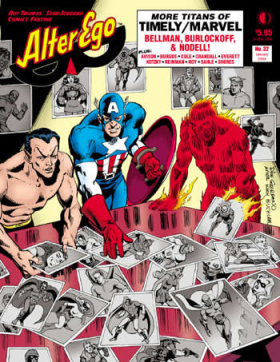Alter Ego #32 January 2004 (magazine review).
There are several iconic comic book covers that are often reinterpreted with different characters due to their effectiveness. One such example is Rich Buckler’s All-Star Squadron #1 from 1981 for DC Comics. In this case, Dick Giordano creates his version featuring Timely’s ‘All-Winner Squad’, and we get to see both his pencil work and the final cover.
Let’s dive into the contents. The first interview features artist Allen Bellman (1924-2020), who was pleasantly surprised to be remembered when Michael J. Vassallo reached out to him. In 2004, he was also surprised to learn that his former artist colleague, Sam Burlockoff, was still alive when he had believed him to be deceased. Bellman emphasizes the importance of preserving living history by sharing stories from those who were present at the time. He provides information about many of the people he worked with before eventually freelancing from home. His work spanned various comic books, including Captain America. Interestingly, he referred to those who worked on cartoon-based comic books as “animators.”
The subsequent interview by Jim Amash with penciller/inker Sam Burlockoff (1924-2007) is equally informative. A notable insight is that many artists turned to inking for economic reasons, as they could complete three times the work of a penciller in the same amount of time. Burlockoff, who did both, returned to painting in retirement. His knowledge of the creative staff at different companies offers valuable perspective. Unfortunately, both Bellman and Burlockoff have since passed away, making these interviews even more significant.
A smaller interview with Mart Nodell, the creator of the original Green Lantern, by Blake Bell, covers similar ground before Nodell transitioned to the better-paying advertising industry.
Flipping the magazine over, we remain in “Alter Ego” territory with the Fawcett section, which includes more articles covering the 1960s and 70s. Writer/editor Mike Gold examines DC Comics’ transition into the Silver Age and how editors initially focused on sales rather than catering to readers’ desires, eventually giving in to reader preferences. Without this shift, we wouldn’t have had the Superboy tales that led to Bizarro and the Legion of Super-Heroes.
Other articles primarily focus on the 1950s. Jim Vadeboncoeur, Jr. explores the work of Italian artist Alberto Becattini, who used the pen name “Martin” in the US because editors couldn’t pronounce his surname. With dual nationality, he traveled between the two countries working in various genres. His art samples reveal a distinctive style.
The issue also includes an obituary for artist Pete Morisi (1928-2003), whose work has been featured in later “Alter Ego” issues. Michael T. Gilbert’s “Mr. Monster” examines another “Eerie Tales” magazine, which Jim Warren wanted to ensure didn’t share the same name. This is the first time its art has been showcased, and a quick name change might have led to its success.
Writer Bill Schelly commemorates the death of William Joseph White, also known as Biljo White (1929-2003), one of the founding fathers of American comic book fandom. White was primarily known for his “Batmania” fanzine and his own range of characters.
There is a wealth of information in this issue, making it worthwhile to seek out early editions if you prefer physical copies.
GF Willmetts
April 2023
(pub: TwoMorrows Publishing. 90 page illustrated magazine. Price: (US). ISSN: 1932-6890. Direct from them, y ou can get it digitally for $ 4.99 (US))
check out websites: www.TwoMorrows.com and https://twomorrows.com/index.php?main_page=product_info&cPath=98_55&products_id=475






